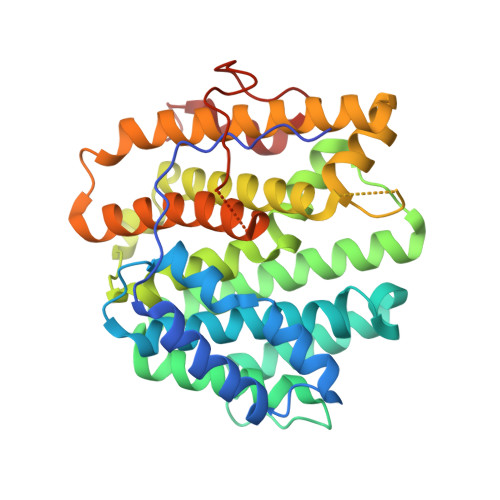Engineering of Ancestors as a Tool to Elucidate Structure, Mechanism, and Specificity of Extant Terpene Cyclase.
Schriever, K., Saenz-Mendez, P., Rudraraju, R.S., Hendrikse, N.M., Hudson, E.P., Biundo, A., Schnell, R., Syren, P.O.(2021) J Am Chem Soc 143: 3794-3807
- PubMed: 33496585
- DOI: https://doi.org/10.1021/jacs.0c10214
- Primary Citation of Related Structures:
6TBD, 6THU, 6TIV, 6TJA, 6TJZ - PubMed Abstract:
Structural information is crucial for understanding catalytic mechanisms and to guide enzyme engineering efforts of biocatalysts, such as terpene cyclases. However, low sequence similarity can impede homology modeling, and inherent protein instability presents challenges for structural studies. We hypothesized that X-ray crystallography of engineered thermostable ancestral enzymes can enable access to reliable homology models of extant biocatalysts. We have applied this concept in concert with molecular modeling and enzymatic assays to understand the structure activity relationship of spiroviolene synthase, a class I terpene cyclase, aiming to engineer its specificity. Engineering a surface patch in the reconstructed ancestor afforded a template structure for generation of a high-confidence homology model of the extant enzyme. On the basis of structural considerations, we designed and crystallized ancestral variants with single residue exchanges that exhibited tailored substrate specificity and preserved thermostability. We show how the two single amino acid alterations identified in the ancestral scaffold can be transferred to the extant enzyme, conferring a specificity switch that impacts the extant enzyme's specificity for formation of the diterpene spiroviolene over formation of sesquiterpenes hedycaryol and farnesol by up to 25-fold. This study emphasizes the value of ancestral sequence reconstruction combined with enzyme engineering as a versatile tool in chemical biology.
Organizational Affiliation:
School of Engineering Sciences in Chemistry, Biotechnology and Health, Science for Life Laboratory, KTH Royal Institute of Technology, 114 28 Stockholm, Sweden.














